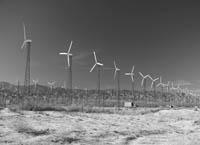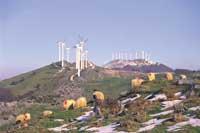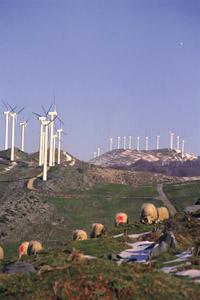Park management with wind turbines
1999/10/01 Tapia Otaegi, Arantza Iturria: Elhuyar aldizkaria

Over the past few years wind power worldwide has been on the rise and, of course, the Basque Country has not been on the sidelines of this trend. On the one hand because it is a source of clean energy and, on the other, because it has decided to boost this type of energy from governments. And it seems that within a few years it will reach 10% of the total energy generated.
Until recently this type of energy was used, mainly due to the low power of the generators. However, currently, research on these generators has radically modified the power generation capacity of wind farms, which is at megawatt levels.
However, as in other cases, the increase in the power of these parks has meant an increase in the problems that are generated in the electricity grid. As a result, the interest of electric companies in these systems, especially in controlling them, is increasing. On the one hand, the operation of the wind farm is not predictable because the power generation capacity depends on the wind and, on the other hand, can take reactive power from the power grid or incorporate reactive power to the grid, decreasing or raising the voltage of the power grid.
To minimize the impact of this reactive power, capacitors are normally placed that make the entire system expensive. However, there are currently generators based on double feed asynchronous machines that have the role of the aforementioned capacitors. The double feed machines are characterized by their feeding by both the stator and the rotor. Consequently, using vector control techniques, active and reactive power can be transferred to the desired values and the machine can circulate with different power factors.
The main objective of operation of the wind farm is to generate maximum power depending on the wind that circulates at all times, without losses, or what is the same, to have a power factor of the asynchronous machines of each of the wind turbines that compose it, obtaining the best economic performance. But even though until the 90s it was so, due to the liberalization of electricity these concepts are changing and in this area the described project is consolidated.
The first step will be to analyze the capabilities of dual-feed machines and build their mathematical model, demonstrating the validity of the model by comparing the behavior of the mathematical model with that of the real machine. It should be noted that in order to carry out a distributed control of the active and reactive power of this machine vector control techniques are used and that the operation of the machine is as close as possible to the power factor that each imposes as a slogan or reference.
But the problem does not end like this, since in the park there are several wind turbines and in addition, everyone does not get the same wind. Consequently, the degree of generation of each generator can be different. Therefore, the next step will be to create and test the mathematical model of the entire park from the mathematical model of a single machine.
On the other hand, in the central offices of the electrical companies, taking into account the parameters of the entire electrical network (generation, state, etc.) and the state of the wind farm (active power generation), determines the reactive power (that is, the power factor of the park) that should be created or absorbed as a park. When this data reaches the Park Control Office another problem arises, that is, how should be the control strategy to implement so that the Park reaches the values that have been set as a reference in general? And this is really the key to the project. This latter objective can be especially important with the liberalization of electricity, since with the generation of the active power can be sold as additional value, as aid to the electricity grid.

Gai honi buruzko eduki gehiago
Elhuyarrek garatutako teknologia





